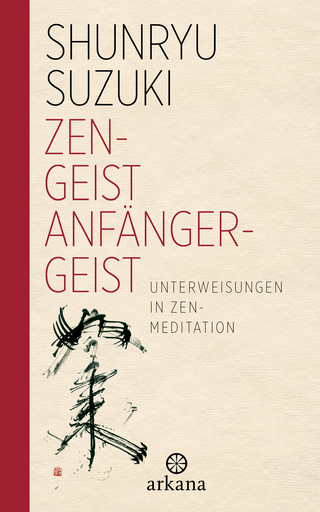
Buddhisms
Oneworld Publications (Verlag)
978-1-78074-505-3 (ISBN)
Buddhism or Buddhisms? By the time they move on to Buddhism in Japan, many students who have studied its origins in India ask whether this is in fact the same religion, so different can they appear. In Buddhisms: An Introduction, Professor John S. Strong provides an overview of the Buddhist tradition in all its different forms around the world. Beginning at the modern day temples of Lumbini, where the Buddha was born, Strong takes us through the life of the Buddha and a study of Buddhist Doctrine, revealing how Buddhism has changed just as it has stayed the same. Finally, Strong examines the nature of Buddhist community life and its development today in the very different environments of Thailand, Japan, and Tibet. Enriched by the author’s own insights gathered over forty years, Buddhisms never loses sight of the personal experience amidst the wide-scope of its subject. Clear in its explanations, replete with tables and suggestions for further reading, this is an essential new work that makes original contributions to the study of this 2,500 year-old religion.
John S. Strong is the Charles A. Dana Professor of Religion, Bates College, in Maine, USA. Specializing in history of religions, Asian religions, and Buddhist Studies, with a focus on Buddhist legendary and cultic traditions in India and South Asia. He is the author of numerous books and articles including The Buddha: A Beginner’s Guide (Oneworld).
Preface
Schemes and Themes
Technicalities
Note on abbreviations
Chapter 1 Introduction: Lumbinī, a Buddhist World Exposition
1.1 Theravāda and Mahāyāna
1.2 Lumbinī’s Eastern Monastic Zone: South and Southeast Asian Traditions
1.2.1 The Mahā Bodhi Society
1.2.2 The Sri Lanka Monastery
1.2.3 The Gautamī Center for Nuns
1.2.4 Myanmar (Burma)
1.2.5 Meditation Centers
1.3 Lumbinī’s Western Monastic Zone: East Asian Traditions
1.3.1 China
1.3.2 Korea
1.3.3 Japan
1.3.4 Vietnam
1.4 Lumbinī’s Western Monastic Zone: Tibetan Vajrayāna Traditions
1.4.1 The Great Lotus Stūpa
1.4.2 The Lumbinī Udyana Mahachaitya
Part I: Foundations of the Triple Gem: Buddha/s, Dharma/s, and Saṃgha/s
Chapter 2 Śākyamuni, Lives and Legends
2.1 The Historical Buddha
2.2 The Buddha’s World
2.3 The Buddha of Story
2.4 Past Buddhas and the Biographical Blueprint
2.5 The Start of Śākyamuni’s Career
2.6 Previous Lives (Jātakas)
2.6.1 The Donkey in the Lion’s Skin
2.6.2 Vessantara Jātaka
2.6.3 The Tigress Jātaka
2.7 A Lifestory of Śākyamuni
2.7.1 Birth and Childhood
2.7.2 Life in the Palace
2.7.3 The Beginnings of Discontent
2.7.4 The Great Departure
2.7.5 Paths Not Taken
2.7.6 Awakening
2.7.7 After Enlightenment
2.7.8 The First Sermon
2.7.9 Various Conversions and Miracles
2.7.10 Death and Parinirvāṇa
Chapter 3 Overcoming the Buddha’s Absence
3.1 Seeing the Buddha in the Dharma
3.1.1 Excursus on the Buddhist Canon/s
3.2 Places of Pilgrimage
3.3 Relics
3.4 Buddha Images
3.5 The Masters of the Dharma
3.6 The Arhat Dharma-Protectors
3.7 Meeting Maitreya
Chapter 4 Some Permutations of the Middle Way
4.1 The Middle Way
4.2 Karma and Saṃsāra
4.2.1 Why Do Good Deeds?
4.2.2 Contexts of Karma I: Neither Free Will nor Determinism
4.2.3 Contexts of Karma II: Both Jain and Upaniṣadic Views
4.3 The Doctrine of Non-Self (Anātman)
4.3.1 Breaking Down the False Sense of Self: the Five Aggregates and Impermanence
4.3.2 The Elements (Dharmas)
4.3.3 Countering the Breakdown of Self: Personal Continuity
4.3.4 Explications of Continuity: Pseudo-Selves and Ersatz Ātmans
4.4 Summary
Chapter 5 The Four Truths
5.1 The First Truth: Stress
5.2 The Second Truth: the Continual Arising of Stress and Interdependent Origination
5.2.1 The Double Bind of Saṃsāra
5.3 The Third Truth: the Cessation of Stress – Nirvāṇa
5.4 The Fourth Truth: the Path to the Cessation of Stress
5.4.1 Moral Discipline
5.4.2 Meditation
5.4.3 Wisdom
5.5 Other Systematizations of the Path
5.5.1 The Seven Factors Conducive to Enlightenment
5.5.2 The Graduated Training
5.5.3 The Four Divine Abidings
5.5.4 The Four Fruits of the Path
5.6 Summary
Chapter 6 The Establishment and Character of the Early Buddhist Community
6.1 Monastic–Lay Interactions
6.1.1 Dāna (Giving) and Other Forms of Making Merit
6.1.2 Lay Ethics
6.1.3 Magical Protection
6.1.4 Laypersons and the Monastic Rules
6.1.5 Royal Supporters
6.1.6 King Aśoka
6.2 The Monastics: Wandering and Settling
6.2.1 Monastic Lifestyles
6.2.2 Monasteries
6.3 Mahāprajāpatī and the Establishment of the Order of Nuns
6.4 Common Moral Commitments
6.5 Initiation Rituals: Wandering Forth and Ordination
6.6 Monastic Rules
6.6.1 The Elaboration of the Disciplinary Code
6.6.2 Enforcement of the Rules: Prātimokṣa Recitation and Pravāraṇa
6.7 Some Exemplary Disciples of the Buddha
6.7.1 Śāriputra and Maudgalyāyana
6.7.2 Paṭācārā
6.7.3 The Laypersons Nakulapitṛ and Nakulamātṛ
6.7.4 Viśākhā, Preeminent Laywoman
6.8 Summary
Chapter 7 Visions and Divisions of the Saṃgha
7.1 Council Stories
7.1.1 The Council at Rājagṛha
7.1.2 Vinaya Disputes: the Council of Vaiśālī
7.1.3 The Councils of Pāṭaliputra
7.1.4 Other Council Traditions
7.2 The Flowering of Mainstream Factionalism
7.3 Other Divisional Issues
7.3.1 Practice vs. Study
7.3.2 Meditators and Merit Makers
7.3.3 Forest Monks and Town Monks
7.3.4 The Question of Asceticism
7.3.5 The Question of Bon-Vivant Monks
7.3.6 Sect vs. Sect
7.4 The Origins of the Mahāyāna
7.5 Proliferation of Mahāyāna Schools
7.5.1 Mahāyāna Schools in India
7.5.2 Mahāyāna Schools in China
7.5.3 Mahāyāna Schools in Japan
7.5.4 Mahāyāna Schools in Tibet
7.6 Summary
Part II: Further Elaborations of the Triple Gem
Chapter 8 Mahāyāna and Vajrayāna Ways of Meeting the Buddha/s
8.1 Changes in the View of the Buddha: the Lotus Sūtra and Śākyamuni’s Lifespan
8.2 Three Bodies of the Buddha/s
8.3 Meeting the Buddha/s in Their Pure Lands
8.3.1 Akṣobhya
8.3.2 Bhaiṣajyaguru
8.4 Amitābha
8.4.1 Meeting Amitābha through Visualization
8.4.2 Rebirth in the Pure Land
8.5 Meeting the Buddha in the Great Bodhisattvas
8.5.1 Avalokiteśvara
8.5.2 Other Great Bodhisattvas
8.6 Meeting the Buddha/s in the Vajrayāna
8.6.1 Maṇḍalas and the Five Tathāgatas
8.6.2 Ritual Consecration (Abhiṣeka)
8.6.3 Merging with the Buddha
8.6.4 Visions: Meeting the Buddha/s in Bardo
8.6.5 Buddha Embodiments in This World: Gurus and Tülkus
8.7 Summary
Chapter 9 Māhāyana Doctrinal Developments
9.1 Emptiness: the Selflessness of Dharmas
9.2 Nāgārjuna and the Madhyamaka
9.3 The Expansion of Provisional Truth: Expedient Means (Upāya)
9.4 Tiantai Doctrines
9.5 The Ongoing Dialectic: the Yogācāra School
9.5.1 Asanga and Vasubandhu and the Development of the School
9.5.2 Yogācāra Doctrines
9.6 Avataṃsaka Doctrines
9.6.1 Applications of Interpenetration
9.7 The Buddha Womb/Embryo (Tathāgatagarbha) Teachings
9.7.1 Resurgence of the True Self
9.8 Buddha-Nature Controversies
9.8.1 Limitations to the Buddha-Nature: the Icchantika Debate
9.8.2 The End of the Dharma
9.8.3 Expansions of the Buddha-Nature Doctrine
9.9 Summary
Chapter 10 The Bodhisattva Path, Tantra, and Zen
10.1 The Bodhisattva Path
10.2 Sudden and Gradual
10.2.1 Disagreements over the Nature of the Path: the Debate at Samyé
10.2.2 Disagreements over the Nature of Enlightenment
10.3 Graduated Paths
10.3.1 Compassion and Bodhicitta
10.3.2 The Stages of the Path, the Perfections, the Five Paths
10.3.3 Routinization and Ritualization
10.4 Path Shortcuts
10.5 Tantra
10.5.1 Uniting the Poles
10.5.2 Tantric Physiology
10.5.3 Mahāmūdra and Dzokchen (Rdzogs chen)
10.6 Direct Experiences: Chan/Zen
10.6.1 Kōans
10.6.2 Critical Phrases (Huatou)
10.7 Summary
Chapter 11 Saṃgha Situations: Places, Persons, and Practices in Thai Buddhism/s
11.1 Buddhism in Thailand
11.2 Thai Monastic Life: Temporary Ordination
11.2.1 Life as a Novice
11.2.2 Experiences as a Monk
11.3 The Lives of Two Charismatic Thai Monks
11.3.1 Acharn Mun
11.3.2 Khruba Siwichai
11.4 The End of the Rains-Retreat in a Northern Thai Village
11.5 A Thai Temple in Wimbledon, England
Chapter 12 Saṃgha Situations: Places, Persons, and Practices in Japanese Buddhism/s
12.1 The Hexagonal Hall (Rokkakudō)
12.1.1 Prince Shōtoku
12.1.2 Shinran
12.1.3 Kannon, Jizō, and Fudō
12.2 The Ritual Year at Shinnyodō
12.2.1 New Year’s
12.2.2 Ḍākinī and the Recitation of the Great Perfection of Wisdom Sūtra
12.2.3 Main Hall Rituals
12.2.4 Goma
12.2.5 The Killing Stone
12.3 The Ryōanji Rock Garden
12.4 The Buddha’s Birthday at the Morgan Bay Zendō
12.5 The Japan Temple in Lumbinī
12.6 Conclusion
Chapter 13 Saṃgha Situations: Places, Persons, and Practices in Tibetan Buddhism/s
13.1 Lhasa Jokhang
13.1.1 Pinning Down the Demoness
13.1.2 Flood Control
13.1.3 Grand Prostrations
10.1.4 The Great Prayer Festival
13.2 The Potala and the Dalai Lamas
13.2.1 Finding a New Dalai Lama
13.3 Scholars and Mad Saints
13.3.1 Drepung Monastery and Monastic Studies
13.3.2 Mad Monks: the Case of Tangtong Gyalpo
13.4 Samding: Female Incarnations and a Contemporary Buddhist
13.5 A Tibetan Dharma Center in Vermont, U.S.A.
13.6 Conclusion
Appendices
Appendix A: A Short Chronology of Buddhism in India
Appendix B: A Short Chronology of Buddhism in Sri Lanka
Appendix C: A Short Chronology of Buddhism in Myanmar (Burma)
Appendix D: A Short Chronology of Buddhism in Cambodia
Appendix E: A Short Chronology of Buddhism in Thailand
Appendix F: A Short Chronology of Buddhism in China
Appendix G: A Short Chronology of Buddhism in Japan
Appendix H: A Short Chronology of Buddhism in Vietnam
Appendix I: A Short Chronology of Buddhism in Tibet
Bibliography of Works Cited
Index
| Verlagsort | London |
|---|---|
| Sprache | englisch |
| Maße | 153 x 234 mm |
| Themenwelt | Geisteswissenschaften ► Religion / Theologie ► Buddhismus |
| ISBN-10 | 1-78074-505-2 / 1780745052 |
| ISBN-13 | 978-1-78074-505-3 / 9781780745053 |
| Zustand | Neuware |
| Haben Sie eine Frage zum Produkt? |
aus dem Bereich


